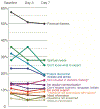Trajectories of Palliative Care Needs in the ICU and Long-Term Psychological Distress Symptoms
- PMID: 36326263
- PMCID: PMC10191149
- DOI: 10.1097/CCM.0000000000005701
Trajectories of Palliative Care Needs in the ICU and Long-Term Psychological Distress Symptoms
Abstract
Objectives: While palliative care needs are assumed to improve during ICU care, few empiric data exist on need trajectories or their impact on long-term outcomes. We aimed to describe trajectories of palliative care needs during ICU care and to determine if changes in needs over 1 week was associated with similar changes in psychological distress symptoms at 3 months.
Design: Prospective cohort study.
Setting: Six adult medical and surgical ICUs.
Participants: Patients receiving mechanical ventilation for greater than or equal to 2 days and their family members.
Measurements and main results: The primary outcome was the 13-item Needs at the End-of-Life Screening Tool (NEST; total score range 0-130) completed by family members at baseline, 3, and 7 days. The Patient Health Questionnaire-9 (PHQ-9), Generalized Anxiety Disorder-7 (GAD-7), and Post-Traumatic Stress Scale (PTSS) were completed at baseline and 3 months. General linear models were used to estimate differences in distress symptoms by change in need (NEST improvement ≥ 10 points or not). One-hundred fifty-nine family members participated (median age, 54.0 yr [interquartile range (IQR), 44.0-63.0 yr], 125 [78.6%] female, 54 [34.0%] African American). At 7 days, 53 (33%) a serious level of overall need and 35 (22%) ranked greater than or equal to 1 individual need at the highest severity level. NEST scores improved greater than or equal to 10 points in only 47 (30%). Median NEST scores were 22 (IQR, 12-40) at baseline and 19 (IQR, 9-37) at 7 days (change, -2.0; IQR, -11.0 to 5.0; p = 0.12). There were no differences in PHQ-9, GAD-7, or PTSS change scores by change in NEST score (all p > 0.15).
Conclusions: Serious palliative care needs were common and persistent among families during ICU care. Improvement in needs was not associated with less psychological distress at 3 months. Serious needs may be commonly underrecognized in current practice.
Copyright © 2022 by the Society of Critical Care Medicine and Wolters Kluwer Health, Inc. All Rights Reserved.
Conflict of interest statement
Drs. Cox, Ashana, Olsen, Casarett, Naglee, Riley, Johnson, and Docherty received support for article research from the National Institutes of Health (NIH). Drs. Ashana and Olsen disclosed government work. Drs. Olsen’s, Casarett’s, and Docherty’s institutions received funding from the NIH. Dr. Casarett received funding from Curio Wellness, the American Academy of Hospice and Palliative Medicine, Melix, and Clever Leaves Bristol Hospice DisposeRx. Dr. Dempsey disclosed work for hire. The remaining authors have disclosed that they do not have any potential conflicts of interest.
Figures



Comment in
-
Chuck the Old Compass for a New One: Navigating Palliative Care in the ICU.Crit Care Med. 2023 Jan 1;51(1):141-143. doi: 10.1097/CCM.0000000000005722. Epub 2022 Dec 15. Crit Care Med. 2023. PMID: 36519988 No abstract available.
References
-
- Cameron JI, Chu LM, Matte A, et al. : One-year outcomes in caregivers of critically ill patients. N Engl J Med 2016; 374(19):1831–1841 - PubMed
-
- Truog RD, Campbell ML, Curtis JR, et al. : Recommendations for end-of-life care in the intensive care unit: a consensus statement by the American College of Critical Care Medicine. Crit Care Med 2008; 36(3):953–963 - PubMed
Publication types
MeSH terms
Grants and funding
LinkOut - more resources
Full Text Sources
Medical

